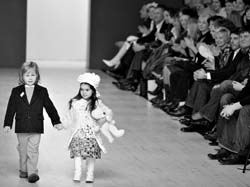A season of style

March 14 saw the launching of a high-profile Ukrainian Fashion Week. The event not only gathered a host of fashion buffs in front of the catwalk but also got the entire Ukraine riveted to televisions during the live show. This event is proudly called the main driving force for the Ukrainian fashion industry. It is a manifestation of the most refined national tastes and evidence of our designers’ high potential and competitive professionalism. This applies, for example, to Lilia Pustovit, whose items vanish in a flash from Moscow boutique windows. By tradition, it was her collection that opened the Ukrainian Fashion Week.
Silk, simple lines, and graphic shapes are quite in the style of Pustovit who is constantly searching for new ideas and the ways of implementing them. Lilia created her items by merging deeply authentic motifs and ultramodern worldwide trends. The first day of fashion also included the show of Victoria Gres by Gred, Nota Bene Luvi, and Wawa collections.
Victoria Gres displayed a collection permeated by the spirit of Paris and prompted by the subtle image of Amelie from a cult film of the same name. Using natural fabrics, such as wool, silk, cotton, and velvet, and autumnal colors (brown , yellow, greenish and ochreous), the designer created the portrait of an elegant Paris woman with a peculiar individuality. On the other hand, the duet of young designers, who presented the Nota Bene Luvi brand, was inspired by characters of Andy Warhol’s “factory.” They tried to turn a present- day glamorous hangout into 1960s bohemian youth gathering, where everybody was a star that shone brighter than gold.
An unconventional Wawa tandem (designer Viktor Anisimov and soccer player Vladyslav Vashchuk) presented, fairly enough, a sporting-style collection. The also used gold, expected to be all the rage next year, which added club chic to black things. They put emphasis on the accessories, among which the golden key dominated as a symbol of the achieved goal. What drew most attention in the next days were, in particular, the shows of the Georgian designer Avtandil Tskvitinidze, already a big name in Ukraine after a few previous fashion weeks, the eccentric Oleksii Zalevsky, the minimalist Andre Tan, the Victoria Gres Denim brand displayed to the accompaniment of the group Borsch, as well as the parade of the German lady designer Annete Goertz. Tskvitinidze dressed his models in strict tapered black suits and blouses.
Zalevsky sexed up his show with the music of Placebo and Muse and such futuristic items as plastic helm-shaped hats and silvery dresses. The young Tan’s collection stirred up the greatest ripple, among both the stars and ordinary admirers of his talent. The leitmotif of his collection was also a futuristic search and a “cosmic” silver color. What became “the in- thing” of his collection was the appearance on the catwalk of the celebrated Ukrainian model Snizhana Onopko who in fact opened the show. The display of Annette Goertz’s collection, which coincided with the opening of her brand boutique in Kyiv, was very European in essence, but it was full of practicalness not typical of our fashion weeks. After seeing a number of parades, one can easily conclude that sneakers and loose-at- hip trousers will be all the vogue next year. We saw both women and men wearing them on the catwalk.
The Ukrainian Fashion Week (UFW) may well be called not only a fashionable event but also the best manifestation of national identity. Thanks to Fashion Seasons and their spin-off, UFW, the Ukrainians are proudly wearing Ukrainian labels.






